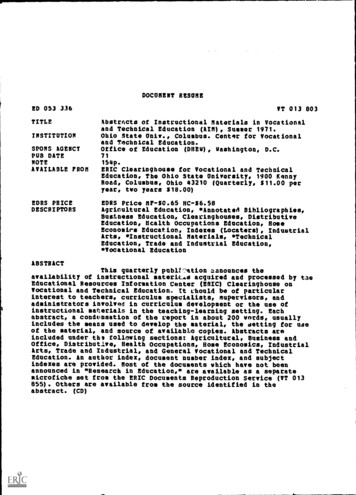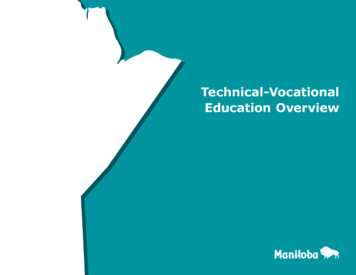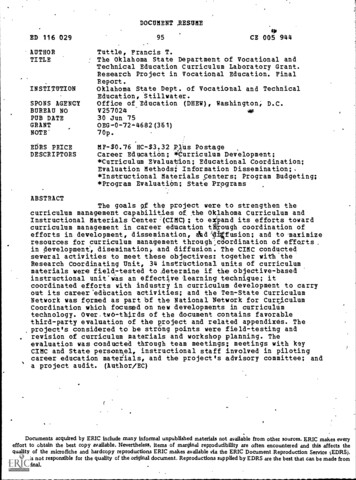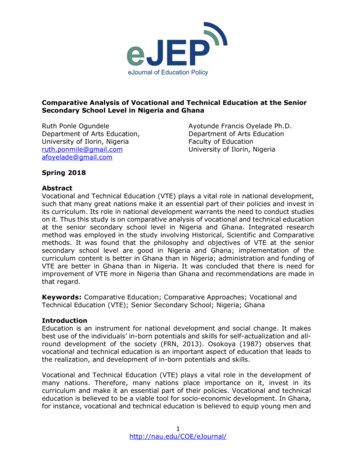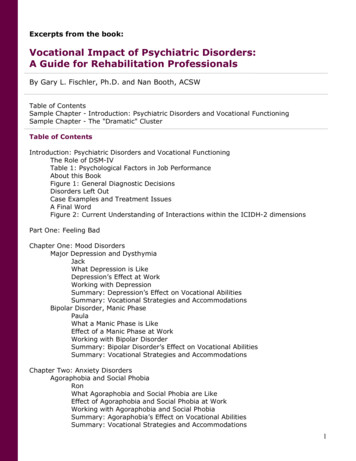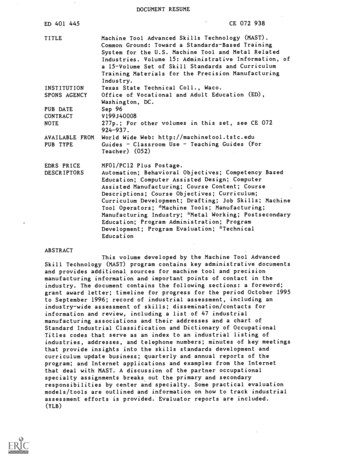
Transcription
International Journal of Humanities Social Sciences and Education (IJHSSE)Volume 8, Issue 7, July 2021, PP 111-118ISSN 2349-0373 (Print) & ISSN 2349-0381 www.arcjournals.orgTechnical and Vocational Education and Training Policy inZimbabwean Secondary Schools: Teachers’ ViewsMichael Mhlanga, John Tenha, Francis NdlovuLecturer, Faculty of Education, Zimbabwe Open University*Corresponding Author: Michael Mhlanga, Lecturer, Faculty of Education, Zimbabwe Open UniversityAbstract: This study sought to investigate the way how schools offering the TVET subjects are implementingthe programme in Zimbabwe using the quantitative methodology. The study adopted the descriptive surveydesign. The target population comprised all secondary school teachers in Seke District. The sample consistedof 240 teachers of which 136 were female and 104 were male. The information was gathered through aquestionnaire. The study revealed that most teachers had a positive attitude towards the TVET programme. Italso revealed that schools faced many challenges as they tried to implement TVET. The study recommendsthat there should be more allocation of financial material and human resources towards TVET in schools.Keywords: Technical education, Vocational education, Secondary schools, Implementation, District,HEXCO1. INTRODUCTIONTechnical and vocational education and training (TVET) has emerged as one of the most effectivehuman resource development strategies that African countries need to embrace in order to train andmodernize their technical workforce for rapid indistrialisation and national development (Afeti, 2014).In almost all countries in Africa, large numbers of graduates coming out of the formal school systemare unemployed, although opportunities for skilled workers do exist in the economy (Baiyin, 2004).This situation has brought into sharp focus the mismatch between what schools offer and labourmarket skill demands (Savage, 2009). Another reason that is often cited for the incidence of highunemployment among graduates is the absence of entrepreneurial training in the school curriculum(Afeti, 2014). In Zimbabwe, technical and vocational education and training gained currency whensome secondary schools offered technical and vocational subjects designed by the Higher EducationExamination Council (HEXCO). HEXCO curricula are designed in close consultation with industryand all National Foundation Certificates (NFC) courses offered in secondary schools therefore, werecharacterized by their relevance to industry and commerce (Zendera, 2013). Furthermore, tostrengthen the teaching and learning of technical and vocational education in schools, the Ministry ofPrimary and Secondary Education has adopted and is implementing a two-pathway educationstructure. The two-pathway structure, which is technically and vocationally biased is meant for postBasic Education (Form 2) to cater for students of different abilities (Policy Circular Number 77 of2006). All secondary schools in Zimbabwe, therefore, are mandated by this policy pronouncement toteach technical and vocational subjects to all their pupils. It is on account of this information that thisstudy set out to investigate challenges that schools encounter as they attempt to implement this policy.2. LITERATURE REVIEWVocational and technical education and training is about work and training for work (Raymond,2007). Immaculate (2006) in his opinion said that technical and vocational education are workexperiences meant to be imparted to an individual systematically in order to get him or her adequatelyequipped for good employment in a recognized occupation. According to Brickmen (2006),vocational and technical education and training includes numerous occupational areas such asagriculture, various trades, health services and technical training. On the other hand, Nwogu andNwanoruo (2011) perceive vocational technical educational and training as an educational trainingwhich has been designed technically and systematically to accommodate both the trainer and theInternational Journal of Humanities Social Sciences and Education (IJHSSE)Page 111
Technical and Vocational Education and Training Policy in Zimbabwean Secondary Schools: Teachers’Viewstrainee in order to enable most importantly, the trainee acquire the basic knowledge, skills abilities,understanding and attitudes needed for one’s efficient performance in his/her chosen occupationalcarrier for self-reliance and national development.According to Mpofu (2012) the 2001 United Nations Educational, Scientific and CulturalOrganisations (UNESCO) and Interntional Labour Organisations (ILO) General Conference onTechnical and Vocational Education and Training (2002) TVET involves those aspects of theeducational process in addition to general education, the study of technologies and knowledge relatedto occupations in various sectors of economic and social life (Foster, 2007). Societal and economicdevelopment depends on the strength of TVET provision through the education system as it providesaccess to skills and entry routes into the labour markets (Nyerere, 2009). Savage (2009) states thatTVET includes technical education which essentially refers to theoretical vocational preparation ofstudents for jobs involving applied science and modern technology. It emphasizes the understandingof basic principles of science and mathematics and their practical application rather than the actualattainment of proficiency in manual skills as is the case with vocational education (Savage, 2009).Vocational education and training on the other hand, prepare learners for jobs that are based onmanual and practical activities, traditionally non-theoretical and totally related to specific trades,occupations, or vocation (Pillay, 2005).The technical and vocational education implementation as an education strategy requires substantialfinancial commitments and dedicated key stakeholders’ support and commitment (Bennel, 2009).Investing in a strong, public technical and vocational education and training (TVET) sector must becrucial in knowledge-based societies in developed as well as developing countries (Baiyin, 2004).The UNESCO (2001) revised recommendations on TVET, assert that, given the immense scientific,technological and socio-economic development, either in progress or envisaged, which characterizethe present era, particularly globalization and the revolution in Information CommunicationTechnology, TVET should be given central role in the educational process in all countries as itenriches a person for life and it provides the competencies which are necessary in modern states(Savage, 2009).According to findings by Fuller (2006), not only can TVET support the socio-economic welfare ofindividuals, but it can also increase their international competitiveness. Currently, as Gatawa (2009)argues, technological changes are taking place at an extremely fast pace in a fast globalizing world.The gap in knowledge and ownership of advanced technologies between developing and developedcountries has always been large, with developing countries often adopting technologies and solutionsinnovated elsewhere and lacking the capacity and resources to adapt most of the technologies to thelocal context (Bennel, 2009). Transfer of knowledge therefore through TVET coupled with creativeskills and career guidance, can raise the innovative capacity of developing countries allowing them toinnovate quality technological solutions for their own context and for export and keep up with thedeveloped world (Zendera, 2013).There are many challenges that schools trying to implement TVET face particularly in developingcountries. For example, as Immaculate (2006) postulates, technical and vocational education has beenconsidered as a career path for the less academically endowed, and this perception has been fuelled bythe low academic requirements for admissions into TVET programmes and the limited prospects forfurther education and professional development. As Zendera (2013) observes, what worsens thisperception is that governments create the impression that the primary objective of vocationaleducation programme is to keep drop outs; that is, students who are unable to move up the educationalladder, not because of poor grades, but because of lack of places at the higher level from the basic andsecondary school systems off the streets, rather than projecting the project as an effective strategy totrain skilled workers for the employment market and for sustainable livelihoods.The other challenge with TVET programmes is that they are competing with academic subjects.Academic education is found by most students and parents to provide a route to better jobs andincomes than other forms of education (Pillay, 2005). With this is mind, students were likely to havea negative attitude towards TVET. As Gichira (2002) posits, aspects such as high probability ofgetting employment after following a certain course of education results in students developingpositive attitudes towards the learning content.International Journal of Humanities Social Sciences and Education (IJHSSE)Page 112
Technical and Vocational Education and Training Policy in Zimbabwean Secondary Schools: Teachers’ViewsFuller (2006) notes that inadequate technical experts to drive TVET systems is another challengemilitating against effective TVET provision. There is general lack of professional specialist teachers,education managers and policy makers with adequate expertise and insight in the formulation andimplementation of vocational education and training programmes (Gichira, 2002). The TVET staff inmany countries lacked the technical capacity to develop national qualifications, courses, competencybased curricula and training packages as well as quality assurance and accreditation standards inTVET (Zendera, 2013).3. STATEMENT OF THE PROBLEMNumerous attempts to vocationalise the secondary school education system before and afterindependence in Zimbabwe have been made without much success. This study sought to examine theextent to which secondary schools are implementing the new TVET policy in Zimbabwe.4. PURPOSE OF THE STUDYThe study sought to establish teachers’ perceptions on challenges that their schools faced during theimplementation of the technical and vocational education and training programme in order to come upwith practical suggestions to improve the situation.5. RESEARCH QUESTIONS1. What are the teachers’ views toward technical and vocational education and training?2. What are the challenges faced by schools in implementing the TVET programme.3. How can schools be assisted to better implement the TVET programme?6. SIGNIFICANCE OF THE STUDYThe study’s importance is premised on the assumption that if TVET programmes’ implementationchallenges are established; this would enable all stakeholders to put their heads together to come upwith strategies to improve the situation.7. LIMITATIONS OF THE STUDYThe study employed a relatively small sample to make generalisations about the whole of Zimbabwe.The other limitation has to do with the descriptive method that was used in this study. According toKumar (2008), the descriptive method lacks predictive power, the research may discover and describe“what is” but is unable to predict “what would be”. The respondents may also give false responsesthereby affecting the validity of the findings.8. DELIMITATIONS OF THE STUDYThe study was delimited to teachers’ perceptions on challenges faced by rural secondary schools inthe implementation of technical and vocational education and training (TVET) using a sample of 120teachers from Seke District in Zimbabwe. Perceptions from other stakeholders like heads of schools,parents, education officers and pupils were outside the purview of this study.9. RESEARCH METHODOLOGYThe study adopted the quantitative research paradigm and made use of a descriptive survey researchdesign. According to Creswell (2009) the descriptive survey design looks with intense accuracy at thephenomenon of the moment and then describes precisely what the researcher sees. The questionnairewas used as the instrument for collecting data. As Chawawa (2012) observes, the questionnaireincreases reliability because of its greater impersonality. However, as Bell (2011) posits, its majorweakness is that it may invite people to lie and answer questions vaguely. This was mitigated throughthe use of pilot testing of the questionnaire. The sample consisted of 120 teachers of which 68 werefemale and 52 were male. Simple random sampling was used to select the respondents.10. DATA COLLECTION AND ANALYSISData were collected by means of a questionnaire which was largely made up of close-ended questionsand one open-ended question. The questionnaire was chosen because as Blumberg (2008) postulates,it has the ability to reach many respondents who live at widely dispersed addresses and preservesInternational Journal of Humanities Social Sciences and Education (IJHSSE)Page 113
Technical and Vocational Education and Training Policy in Zimbabwean Secondary Schools: Teachers’Viewsanonymity which encourages greater honesty. However, as Anderson (2011) posits, the questionnairegenerally has a low response rate and is inflexible in that it does not allow ideas or comments to beexplored in-depth and many questions may remain unanswered. The researchers personallydistributed the questionnaires to the schools understudy. The same method was used to collect thecompleted questionnaires in order to maximize on the rate of return of the instrument. Non-returns asBorg and Gall (2012) argue, introduce a bias in as much as they are likely to differ in many ways fromrespondents thereby adversely affecting reliability and validity of the findings. Data produced fromthe questionnaire produced descriptive statistics around the variables under study. These statisticswere computed and inferential implications from them derived and recorded.11. FINDINGS AND DISCUSSIONThe study set out to explore teachers’ perceptions on challenges faced by rural secondary schools inthe implementation of the technical and vocational education and training policy in Zimbabwe. Thissection is presented in two parts, namely, presentation of data and discussion.12. PRESENTATION OF DATATable1. Distribution of Respondents by Sex (N 4357100Table 1 above shows that there were more female respondents than male ones. The datum wasconsidered statistically significant to the extent that it confirmed that most schools in Zimbabwe hadmore female teachers than male ones.Table2. Composition of Respondents by Age (N 240)Age in YearsBelow 2020 – 2930 – 3940 – 4950 and 00The information on table 2 above reveals that the majority of the respondents are within the 30 – 49age range (87%). Those below 30 years constituted 10% of the respondents and the 50 and above agerange were a mere 3% of the sample.Table3. Composition of Respondents by Areas of Specializations (N 240)Area of Frequency1883688240Percentage791533100Table 3 above shows that the majority of teachers in the sample (79%) specialized to teach Artssubjects, 15% specialized to teach sciences and those who specialiased to teach practical and technicalsubjects were 3% apiece.Table4. Composition of respondents by TVET subjects taught (N 240)SubjectAgricultureWoodworkMetalworkFood and nutritionFashion and ional Journal of Humanities Social Sciences and Education (IJHSSE)Page 114
Technical and Vocational Education and Training Policy in Zimbabwean Secondary Schools: Teachers’ViewsTechnical graphicsBuildingComputer studiesAccountsPhysical educationArt and craftN/ATotal10830202414402404313810716100The information on table 4 above shows that the majority of respondents (84%) teach one practical ortechnical subject or the other and yet the majority of them do not hold qualifications to teach theseareas as depicted in table 3 above. Only 16% of the respondents indicated that they did not teachpractical subjects.Table5. Challenges faced by teachers in TVET implementation (N 240)Rank123456789TotalsChallengeLack of expertiseLack of equipmentShortage of textbooksShortage of specialist roomsInadequate timeLack of industrial attachmentInadequate fundingStudents’ negative attitudesLack of parental 1613118752100The information on table 5 above shows the major challenges faced by teachers ranked according tothe highest to the lowest frequencies. The picture reveals that many respondents (20%) werechallenged by lack of expertise to teach TVTE curricula, followed by lack of equipment (18%),shortage of basic books (16%), shortage of specialist rooms (13%), lack of industrial attachment, forpupils (8%), inadequate funding (8%), students’ negative attitudes (5%) as well as lack of parentalsupport (2%).The questionnaire had one open-ended question which wanted to find out from the respondents whatthey felt could be done to improve the implementation of TVET programmmes in their schools. Themost common responses included the following: Technical and vocational education and training subjects should be made compulsory for allpupils. There should be career guidance for pupils so that they appreciate the value of these subjects. Schools should engage other stakeholders particularly industry for attachment of pupils. Schools within zones and clusters should collaborate to assist each other on these subjects. Schools should be electrified and also have generators on stand by since most of these subjectsrequire electricity. Colleges and universities should train more TVET teachers. Provide incentives for TVET teachers to attract them to teach in the rural areas.13. DISCUSSIONThe findings reveal that the majority of teachers in the study were female. This information wasconsidered statistically significant to the extent that it confirmed that most schools in Zimbabwe hadmore female teachers than male ones. The implications of this finding are that boys may bedisadvantaged if most female teachers specialised in those practical and technical areas viewed bystudents (boys) as courses for girls. Such stereotypes are common in schools where you find very fewboys doing areas like needlework, cookery or fashion and fabrics, because the boys, throughInternational Journal of Humanities Social Sciences and Education (IJHSSE)Page 115
Technical and Vocational Education and Training Policy in Zimbabwean Secondary Schools: Teachers’Viewssocialization view them as feminine subjects. This is corroborated by observations by Bennel (2009)who discovered that the socialization of most African boys discouraged them from doing thosesubjects that their culture preserved for the girls.The study revealed that the majority of respondents specialized in Arts subjects. Very few teachersunder study had specialized in practical and technical subjects. This corroborates information byZendera (2013) who states that one factor militating against effective implementation of TVETprovision in schools is general lack of professional specialist teachers. The nature of technical andvocational subjects is such that those teachers who teach them should have undergone rigoroustraining to acquire the necessary skills and knowledge to impart to pupils and not just the theoreticalaspects of the areas.Data from the study also reveal that the majority of teachers were assigned to teach one practicalsubject or the other. This, inspite of the fact that the majority of the teachers were not qualified toteach these subject areas. The effects of this information are that, first of all, pupils receive inadequateinformation from these ill equipped teachers; secondly; the teachers are forced by authorities to teachthese areas because under normal circumstances no teacher would opt to teach in an area where theyare fully aware of their lack of capacity. This then breeds a lot of conflict and animosity betweenteachers and heads of schools. As Raymond (2007) argued, where teachers are compelled to teachthere is always bound to be passive resistance through teaching the basics at the expense of corematerial on the subject thereby disadvantaging the learners.The study revealed that schools experience a multiplicity of challenges during the implementation ofTVET programmes. These challenges among others, included lack of expertise amongst the teachers,lack of equipment to properly teach the subjects, shortage of specialist rooms for the practicalteaching of these subjects, inadequate time due to shortage of qualified teachers since the subjects aretaught by teachers who teach in other areas, failure by schools to find industrial attachment for theirpupils, lack of funding as well as lack of support from parents. The above challenges render the wholeimplementation process of the TVET programmes an impossible mission. This finding tallies withobservations by Bennel (2009) who postulates that technical and vocational education implementationas an education strategy requires substantial financial commitments and dedicated key stakeholders’support and commitment.Data from the study also revealed that most students and parents had negative attitudes towards thetechnical and vocational subjects. Where students were expected to choose subject areas (for exampleat Form Three level) with a combination of academic and practical subjects, the majority opted for theacademic areas in spite of the advice from teachers. Where they were coerced to take these subjects,in most cases, they would not register them for the Ordinary Level Examinations as parents would besaid to have discouraged them from registering for them. This is corroborated by observations byPillay (2005) who states that, the other challenge with TVET programmes is that they are competingwith academic subjects. Academic education is found by most students and parents to provide a routeto better jobs and incomes than other forms of education. With this in mind, students were likely tohave a negative attitude towards TVET. As Gichura (2002) argues, aspects such as high probability ofgetting employment after following a certain course of education results in students developingpositive attitudes towards the learning content.14. CONCLUSIONSGiven the background of the above findings, the researchers make the following conclusions: Both theoretical and empirical data in this study converge on the fact that most Zimbabweansecondary schools are struggling to implement the technical and vocational education and trainingpolicy. The majority of teachers assigned to teach practical and technical subjects were not in possessionof the required qualifications to effectively implement the policy. There is lack of equipment in the schools to properly teach pupils the full aspects of TVET in theschools.International Journal of Humanities Social Sciences and Education (IJHSSE)Page 116
Technical and Vocational Education and Training Policy in Zimbabwean Secondary Schools: Teachers’Views Schools do not have specialist rooms for the practical activities for the TVET programmes. Most schools find it difficult to secure places for industrial attachment for their pupils. Schools lack the financial resources to adequately implement TVET programmes. Most students and parents had negative attitudes towards the technical and vocational subjects.15. RECOMMENDATIONSIn light of the findings of this study, the researchers would like to make some recommendations. The Ministry of Primary and Secondary Education should provide appropriate and adequatematerial resources like equipment, consumables and textbooks, to ensure effectiveimplementation of TVET in schools. The corporate sector should be engaged and requested to adopt certain disadvantaged schools soas to support their TVET programmes. Universities like the Zimbabwe Open University should be contracted to publish modules toprovide TVET study materials using their state of the art printing machines at lower costs. There should be TVET district based education officers to guide heads and teachers on theimplementation of TVET programmes. In order to develop business operational skills among the pupils, and enhance chances of selfemployment, entrepreneurship courses should be an integral part of TVET courses. Schools should have fully functional guidance and counselling departments or units to guidepupils on various career paths including opportunities availed by TVET courses.REFERENCESAfeti, G. (2014). Technical and vocational evaluation and training for industrialization in Africa. Lagos:Research and Resource Forum.Anderson, L. (2011). Research in education. Sydney: Allen Unwin.Baiyin, Y. (2004). Holistic learning theory and implications for human resource development. Advance inDeveloping Human Resources Journal, 24 (6) 242-261.Bassey, I. E. (2009). Recreating primary education for patriotism and self-reliance. Implications for teachereducation. Journal of Qualitative Education, 5(1) 7-14.Bell, J. (2011). Doing your research methods. Buckingham: Open University.Bennel, P. (2009). Learning to change: Skills development among the vulnerable and socially Excluded indeveloping countries. Geneva: Employment and Training Council.Blumberg, C. (2008). Research methods. Boston: Irwin.Borg, W. R. and Gall, M. D. (2012). Educational research: An introduction. New York: Havard BracePublishing Company.Chawawa, M. (2012). TVET program implementation. Harare: Zimbabwe Open University.Cresswell, J. W. (2009). Research design: Quantitative, qualitative and mixed methods. Thousand Oaks; C.A:Sage Publications.Foster, P. J. (2007). Vocational school fallacy in developing countries. New York: Oxford University Press.Fuller, W. A. (2006). Pre-employment vocational trade training: The case of India. London: Falmer Press.Gatawa, B.B.S. (1999). The politics of social curriculum: An introduction. Harare: College Press.Gichira, R. (2002). Ensuring relevance and quality in TVET and entrepreneurship education. Nairobi:Government Press.Immaculate, E. E. (2006). The funding needs of vocational and technical education programmes in Nigeria’sschool system. JONATT, 6 (2) 18-21.Kumar, F. S. (2008). Research in educational settings. London: University of London.Mpofu, P.C. (2012). Vocational and technical curriculum versus the academic curriculum. Harare: Universityof Zimbabwe.International Journal of Humanities Social Sciences and Education (IJHSSE)Page 117
Technical and Vocational Education and Training Policy in Zimbabwean Secondary Schools: Teachers’ViewsNwogu, P. O. and Nwanoruo, C. C. (2011). Vovational technical education and training for self-Reliance:Towards national development. Mediterranean Journal of Social Sciences, Vol (2) 55-59.Nyerere, J. (2009). Education and training (TVET) sector mapping in Kenya: Zero Draft. Nairobi: DutchSchokland TVET programme. Educans Foundation.Pillay, G. F. (2005). Technical and vocational (TVET) systems of selected East Asian countries. WashingtonDC: The World Bank.Policy Circular No. 77 of 2006. The two-pathway education process in Zimbabwe’s secondary schools. Harare:Government Printers.Raymond, E. (2007). Constraints affecting electronics of roadsite technicians in Mirna Metropolist. JONATT. 6(2) 8-14.Savage, T. V. (2009). Teaching self- control through management and discipline. Boston Allyn and Bacon.Zendera, E. (2013). Technical and vocational education and training policy implementation in secondaryschools. Harare: Zimbabwe Open University.Citation: Michael Mhlanga et al. " Technical and Vocational Education and Training Policy in ZimbabweanSecondary Schools: Teachers’ Views” International Journal of Humanities Social Sciences and Education(IJHSSE), vol 8, no. 7, 2021, pp. 111-118. doi: https://doi.org/10.20431/2349- 0381.0807013.Copyright: 2021 Authors. This is an open-access article distributed under the terms of the CreativeCommons Attribution License, which permits unrestricted use, distribution, and reproduction in any medium,provided the original author and source are credited.International Journal of Humanities Social Sciences and Education (IJHSSE)Page 118
teach technical and vocational subjects to all their pupils. It is on account of this information that this study set out to investigate challenges that schools encounter as they attempt to implement this policy. 2. LITERATURE REVIEW Vocational and technical education and training is about work and training for work (Raymond, 2007).

